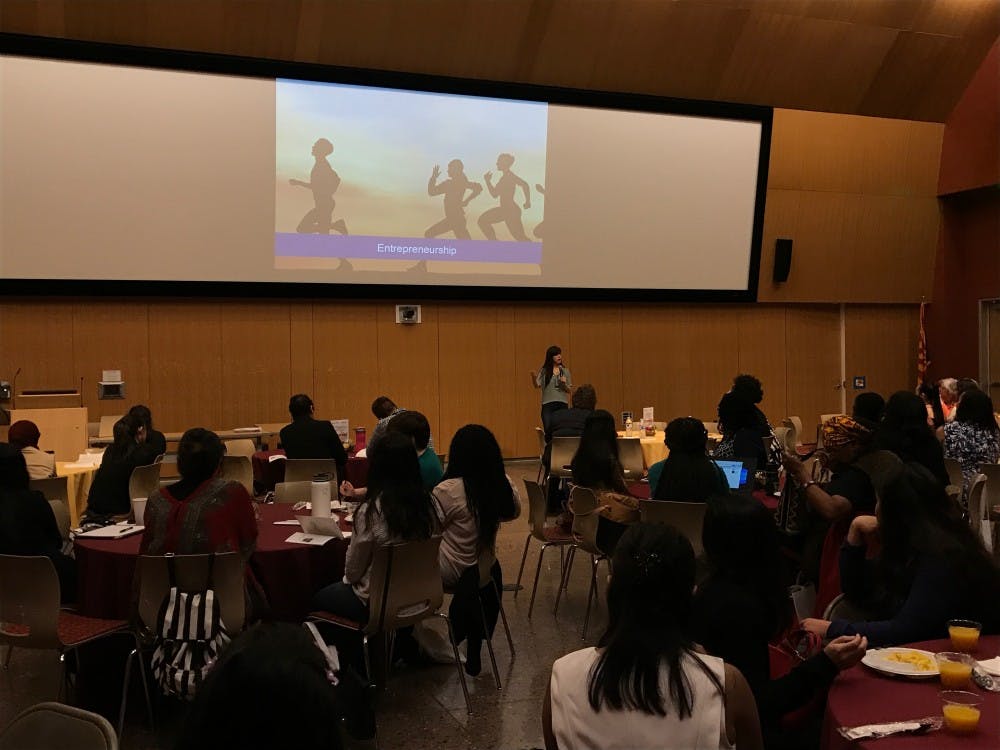The second national Women of Color STEM Entrepreneurship Conference, produced by ASU and held at GateWay Community College, encouraged women to enter science-based fields and worked to dispel racial and gender stereotypes.
The conference, held March 23 to 25, was part of Women’s HERstory Month. The event was produced by ASU’s Center for Gender Equity in Science and Technology (CGEST) and the Office of Entrepreneurship and Innovation.
A few goals of the conference were to further heighten entrepreneurial spirits and call for student engagement in STEM industries. Though the conference highlighted women of color, it was open to anyone interested in pursuing a STEM career.
Laura Gomez, CEO and founder of software startup Atipica, was one of a dozen keynote speakers at the weekend-long conference.
Gomez said she hoped to instill passion for women interested in STEM and entrepreneurship, especially those of color.
“They tried to bury us; they didn’t know that we were seeds,” Gomez said in front of dozens of listeners.
According to the U.S. Bureau of Labor Statistics, women compromise 47 percent of the total U.S. workforce, but are much less represented in particular science and engineering occupations. Women make up 39 percent of chemists and material scientists, 28 percent of environmental scientists and geoscientists, 16 percent of chemical engineers and 12 percent of civil engineers.
Women are 1/3 as likely to access equity financing through angel investments or capital venture (https://t.co/oTLIXHtaXw) #NSTEMC2017 pic.twitter.com/iWOOxtjHMN
— CGEST @ ASU (@CGEST_ASU) March 15, 2017
The conference, entitled “HERstory Is Our Story: Creating a Legacy of STEM Entrepreneurship,” drew 187 participants including high school students, college students, those in academia and industries and many others.
Sharon Torres, the program coordinator and Senior for Advocacy at the CGEST, said the conference is a signature program of the National STEM Collaborative at ASU. The collaborative's goal is to increase participation for women and girls of color in STEM in academia and the industry.
“They (STEM collaborative leaders) found that there’s very little resources focused on entrepreneurship for women of color, so as there are STEM conferences for women of color, there’s none specific to entrepreneurship,” Torres said.
She said the conference provided three main tracks for the “breakout sessions,” including entrepreneurship, “intrapreneurship” and implicit bias. She said that intrapreneurship is taking entrepreneurship skill sets and implementing them within your existing organization.
“So, you may not be the business owner, but you are a key player in the industry," Torres said. "Taking concepts like design thinking and innovation, branding and so on to see yourself grow within an existing organization."
She also defined implicit bias as “preconceived notions that we have without realizing that they are based on someone’s gender, ethnicity, social class and so on.”
Torres expressed the importance of conversations this conference brings about and how the conference is designed as a safe place for women to talk about their concerns but also discuss next steps.
“We know (what) the problem is, now we need to focus on the solutions," Torres said. "We want to focus on the talents, the raw talents, the potential."
Retha Hill, a conference keynote speaker and executive director of the Digital Innovation and Entrepreneurship Lab at ASU, said she was asked to talk about innovation in journalism to prove that there is change happening in whichever industry someone chooses to pursue.
“There’s no room for complacency in journalism, in engineering, in robotics, in mathematics," Hill said. "There’s just no time for that anymore because of the rapid pace of change.”
Students like Annie Johnson, a sophomore studying biology and global studies at ASU, attended the conference on Friday and said encouragement is crucial in uplifting women in STEM fields.
“It’s important, at a young age especially, to enforce the idea that they can do it," Johnson said. "They can go into STEM if they want to, and it’s not a field just for men."
Johnson said she took lots of science classes both in high school and college where she was one of the handful of girls in the class, which felt “bizarre.”
“The good news is that there’s not a monopoly on good ideas or on effort," Hill said. "If you have the confidence in yourself and the attitude to keep trying and trying, there’s room for all of these ideas.”
Hill said that no matter who you are, the STEM workforce needs able-bodied scientists to help cure diseases like cancer or Alzheimer’s Disease.
“The challenges are just so huge, so we can’t afford to leave a whole group of people behind – women, people of color – we just can’t,” she said.
Reach the reporter at cliddle2@asu.edu or follow @Crliddle on Twitter.
Like The State Press on Facebook and follow @statepress on Twitter.




